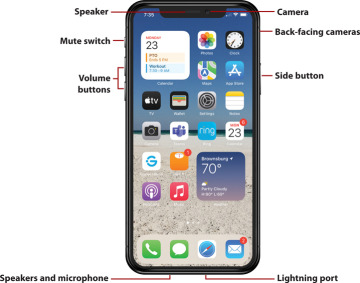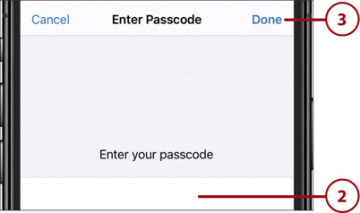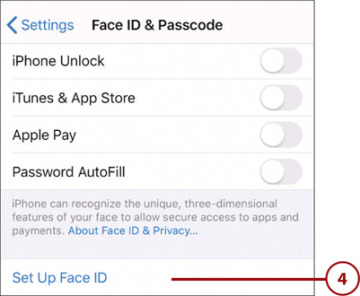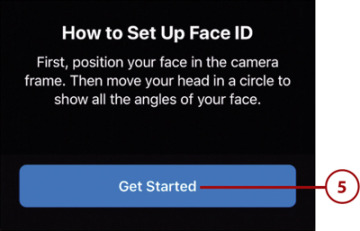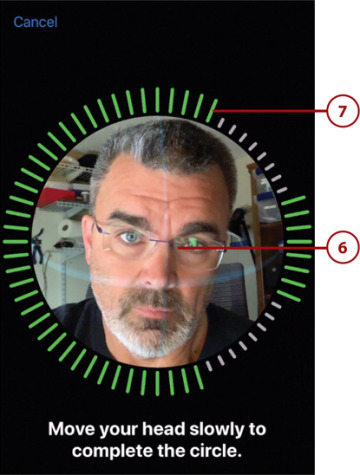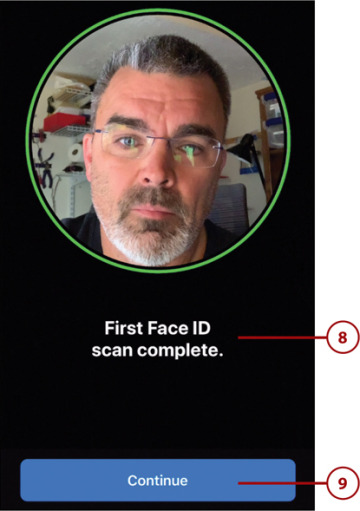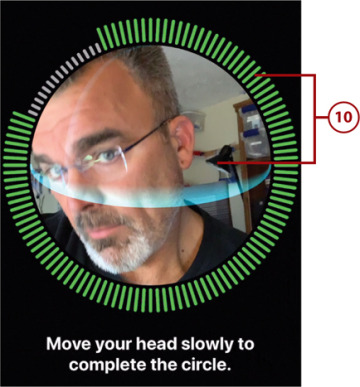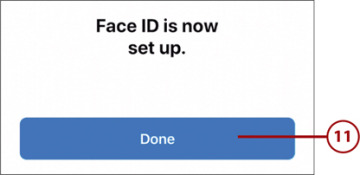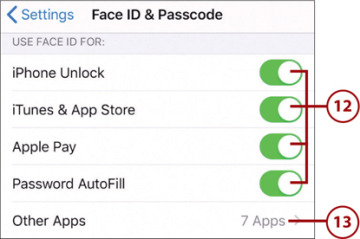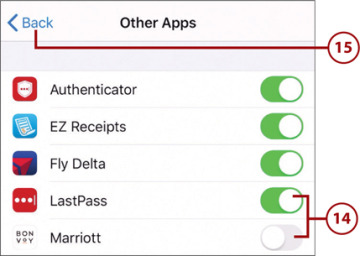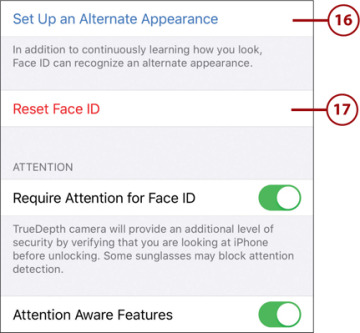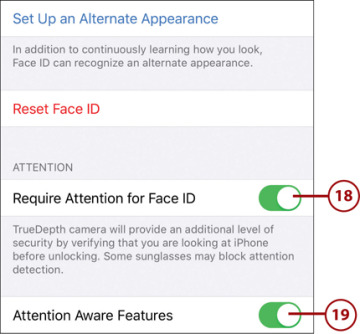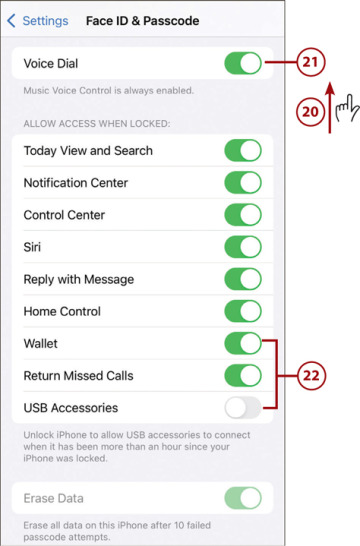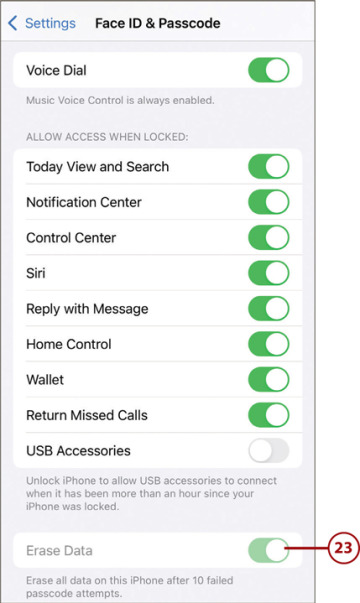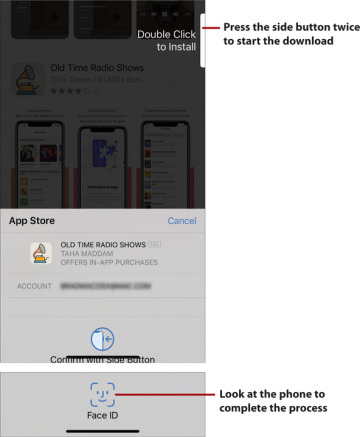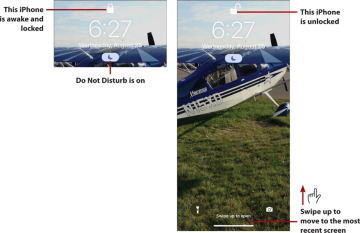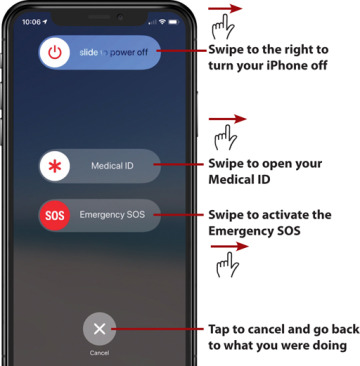- Getting Started
- Getting Started with iPhones without a Touch ID/Home Button
- Getting Started with iPhones with a Touch ID/Home Button
- Using the Split-Screen on iPhone 13 Pro Max, 12 Pro Max, 11 Pro Max, Xs Max, or Plus Models
Getting Started with iPhones without a Touch ID/Home Button
iPhone models without a Touch ID/Home button are the latest generations. They feature Face ID along with improved hardware that makes them work faster than older models. Except for the XR, they have dual or triple cameras on the back that provide for some amazing photographic capabilities, such as enhanced zooming and portrait photos. The iPhone 13 Pro, 13 Pro Max, 12 Pro, and 12 Pro Max also have a Light Detection and Ranging (LiDAR) sensor to improve how the cameras capture images, especially in the Night mode.
Getting to Know the External Features
iPhone models without a Touch ID/Home button have these features:
Cameras—All iPhone models have one camera on the front at the top near the center of the phone; this is the TrueDepth camera that you use for Face ID, selfies, and Animojis (animated emojis).
All of these models also have back-facing cameras that you can use to take all sorts of photos and videos. Different models have different camera configurations that provide a variety of capabilities. The iPhone 13 Pro, 13 Pro Max, 12 Pro, 12 Pro Max, 11 Pro, and 11 Pro Max have three cameras that provide telephoto zoom, Night mode, and wide and ultra-wide shots. The iPhone 13 Pro, 13 Pro Max, 12 Pro, and 12 Pro Max also have a LiDAR sensor to further improve image quality, especially in low-light conditions. The iPhone 13, 13 mini, 12, 12 mini, and 11 have two cameras that provide Night mode, wide, and ultra-wide shots but not telephoto. The XS, XS Max, and X have two cameras that provide wide and telephoto capabilities. The XR has a single camera that can take wide shots.
Side button—Press this button once to lock the iPhone’s screen and put it to sleep, and press it again to wake the iPhone from Sleep mode. When you hold it down for a couple of seconds, you activate Siri. When Face ID is enabled, you press it twice to use Apple Pay, or to download apps from the App Store. Press this button and the top Volume button at the same time to take a screenshot. Press and hold this button and either Volume button to turn the phone off or make an emergency call. When your iPhone is turned off, press and hold this until you see the Apple logo on the screen to turn it on again.
Mute switch—This switch determines whether the iPhone makes sounds, such as ringing when a call comes in. Slide it toward the front of the iPhone to hear sounds. Slide it toward the back of the iPhone to mute all sound. When muted, you see orange in the switch. When you change the switch’s position, you also see an onscreen alert.
Volume buttons—Press the upper button to increase volume; press the lower button to decrease volume. These buttons are contextual; for example, when you are listening to music, they control the music’s volume, but when you aren’t, they control the ringer volume. When you are using the Camera app, pressing either button takes a photo. You also use these in combination with the Side button to perform various actions (refer to the Side button description).
Lightning port—Use this port to plug in wired EarPods or connect your iPhone to a computer or power adapter using the included USB cable. There are also accessories that connect to this port. Lightning plugs are flat, thin, and rectangular. It doesn’t matter which side is up when you plug something into this port.
Speakers and microphone—At the top center of the front of the phone is the speaker you use to listen when you have the phone held against your ear. There are two more speakers located along the bottom edge of the phone. If you’re having a hard time hearing (because of background noise for example), holding this edge to your ear can help.
There is also a microphone located along the bottom edge that captures sound, such as during a phone conversation, when you aren’t using another device (for example, EarPods).
Accessing the Home Screens
On iPhones without a Touch ID/Home button, you move to the Home screens by swiping up from the bottom of the screen. A line indicates the area from which you start your swipe; you don’t have to swipe far to open the Home screens.
Configuring a Passcode and Face ID
A passcode is a series of characters that you must enter to perform specific actions; the most important of which is unlocking your iPhone so you can use it. While you can use an iPhone without a passcode, I strongly recommend that you always use a passcode to protect your iPhone’s data.
When you use Face ID (see the next section), you don’t need to type a passcode very often. Instead, you can simply look at your iPhone’s screen; when your face is recognized, the passcode is entered for you automatically.
When you first started your iPhone, you were prompted to configure a passcode and Face ID. Even if you have already configured a passcode and Face ID, you should know how to change your settings in the event you want to make updates and to ensure you’re making the most of Face ID’s capabilities.
The steps to set up or update your passcode and Face ID follow:
 Tap Settings on the Home screen to open the Settings app and then tap Face ID & Passcode.
Tap Settings on the Home screen to open the Settings app and then tap Face ID & Passcode.
 Enter your passcode.
Enter your passcode.
 Tap Done, if necessary.
Tap Done, if necessary.
 Tap Set Up Face ID if you haven’t used it before.
Tap Set Up Face ID if you haven’t used it before.
 Tap Get Started.
Tap Get Started.
 Look at the iPhone and position your face within the frame. When the iPhone recognizes a face being in the frame, it starts recording your face.
Look at the iPhone and position your face within the frame. When the iPhone recognizes a face being in the frame, it starts recording your face.
 Move your head around in a circle. As you do, the green lines around the circle on the screen fill in, which indicates the part of the image that has been successfully recorded.
Move your head around in a circle. As you do, the green lines around the circle on the screen fill in, which indicates the part of the image that has been successfully recorded.
 Continue moving your head in a circle until all of the green lines are filled in. When the process is complete, you see First Face ID scan complete appear on the screen.
Continue moving your head in a circle until all of the green lines are filled in. When the process is complete, you see First Face ID scan complete appear on the screen.
 Tap Continue. Record your face a second time.
Tap Continue. Record your face a second time.
 Rotate your head until the circle is enclosed by green lines. When the second image has been recorded, Face ID is now set up appears on the screen.
Rotate your head until the circle is enclosed by green lines. When the second image has been recorded, Face ID is now set up appears on the screen.
 Tap Done. You return to the Face ID & Passcode screen.
Tap Done. You return to the Face ID & Passcode screen.
 If you want to use Face ID for one of the options in the USE FACE ID FOR section, set its switch to on (green). (Swipe to the top of the screen to see these switches.) You might need to enter the related passcode or password to complete an action. If you don’t want to use Face ID for an action, set its switch to off (white). I recommend you enable all of these options to make the most of Face ID.
If you want to use Face ID for one of the options in the USE FACE ID FOR section, set its switch to on (green). (Swipe to the top of the screen to see these switches.) You might need to enter the related passcode or password to complete an action. If you don’t want to use Face ID for an action, set its switch to off (white). I recommend you enable all of these options to make the most of Face ID.
 Tap Other Apps (you see this only after other apps have requested and been granted permission to use Face ID).
Tap Other Apps (you see this only after other apps have requested and been granted permission to use Face ID).
 To allow an app to use Face ID, set its switch to on (green); to prevent one of the apps listed from using Face ID, set its switch to off (white). As you make changes, you might need to enter your user account information to work with that app.
To allow an app to use Face ID, set its switch to on (green); to prevent one of the apps listed from using Face ID, set its switch to off (white). As you make changes, you might need to enter your user account information to work with that app.
 Tap Back (<).
Tap Back (<).
 If you want to enable someone else to use Face ID with your iPhone, tap Set Up an Alternate Appearance and follow steps 5 through 11 to record the other person’s face. You can also use this to capture an alternate appearance for yourself in the event your appearance changes so dramatically that it isn’t recognized by Face ID.
If you want to enable someone else to use Face ID with your iPhone, tap Set Up an Alternate Appearance and follow steps 5 through 11 to record the other person’s face. You can also use this to capture an alternate appearance for yourself in the event your appearance changes so dramatically that it isn’t recognized by Face ID.
 To remove the current face being used for Face ID and replace it with a new recording, tap Reset Face ID and follow steps 5 through 11.
To remove the current face being used for Face ID and replace it with a new recording, tap Reset Face ID and follow steps 5 through 11.
 If you don’t want the additional security offered by the Face ID system verifying you’re looking at the iPhone, set the Require Attention for Face ID switch to off (white). You should usually leave this set to on (green). However, if Face ID isn’t working well, try setting this switch to off to see if Face ID works better.
If you don’t want the additional security offered by the Face ID system verifying you’re looking at the iPhone, set the Require Attention for Face ID switch to off (white). You should usually leave this set to on (green). However, if Face ID isn’t working well, try setting this switch to off to see if Face ID works better.
 If you don’t want the TrueDepth camera to check for your attention before the display is dimmed or the alert volume is lowered, set the Attention Aware Features switch to off (white). When this is on (green), if you’re looking at the iPhone, the display won’t be dimmed nor will the alert volume be lowered.
If you don’t want the TrueDepth camera to check for your attention before the display is dimmed or the alert volume is lowered, set the Attention Aware Features switch to off (white). When this is on (green), if you’re looking at the iPhone, the display won’t be dimmed nor will the alert volume be lowered.
 Swipe up the screen until you see the Voice Dial switch.
Swipe up the screen until you see the Voice Dial switch.
 To prevent Voice Dial from working, set the Voice Dial switch to off (white). (Voice Dial enables you to make calls by speaking even if you don’t use Siri.)
To prevent Voice Dial from working, set the Voice Dial switch to off (white). (Voice Dial enables you to make calls by speaking even if you don’t use Siri.)
 Use the switches in the ALLOW ACCESS WHEN LOCKED section to enable or disable the related functions used when your iPhone is locked. If you set a switch to off (white), you won’t be able to access the corresponding function when your iPhone is locked.
Use the switches in the ALLOW ACCESS WHEN LOCKED section to enable or disable the related functions used when your iPhone is locked. If you set a switch to off (white), you won’t be able to access the corresponding function when your iPhone is locked.
 If you want the iPhone to automatically erase all your data after an incorrect passcode has been entered 10 times, set the Erase Data switch to on (green) and tap Enable at the prompt (not shown in the figure). (If the switch is disabled, the setting is turned on already.)
If you want the iPhone to automatically erase all your data after an incorrect passcode has been entered 10 times, set the Erase Data switch to on (green) and tap Enable at the prompt (not shown in the figure). (If the switch is disabled, the setting is turned on already.)
Using Face ID
You can use Face ID to quickly, easily, and securely provide your passcode (for example, to unlock your phone) or a username and password (such as the ones you need to enter to sign into your account on a shopping website).
For example, to download an app using Face ID, move to the app’s screen in the App Store app and tap the Get or price icon. At the prompt, press the Side button twice and look at the phone. When your face is recognized, the app is downloaded and installed. If you see the prompt shown in the figure, look more directly at your iPhone’s screen to complete the action.
Sleeping/Locking and Waking/Unlocking Your iPhone
It’s a good idea to manually lock your iPhone when you aren’t using it to both save battery power and secure your information.
To put your iPhone to sleep and lock it, press the Side button. The screen goes dark and the phone locks.
When an iPhone is asleep/locked, you need to wake it up to use it by touching the screen, pressing the Side button, or raising the iPhone. (See Chapter 7 to learn how to enable or disable this Raise to Wake feature.) The Lock screen appears. If Face ID is enabled, it also unlocks immediately. On the Lock screen, you can tell if the phone is locked or unlocked by the Lock icon.
After your iPhone is unlocked, swipe up from the bottom of the screen. You move back to the screen you most recently used. For example, if you were using the Safari app right before your phone locked, you move back to that app.
Most of the time, unlocking your phone is so seamless that you might not even realize that Face ID has been used. When you wake your phone, you can just swipe up the screen to unlock it. Face ID works quickly, and, as long as you are looking at the phone when you swipe up the screen, you won’t even notice Face ID unlocking the phone for you.
Turning Your iPhone Off or On
You seldom need to turn your iPhone off, but you might want to if you aren’t going to be using it for a while or for troubleshooting purposes.
To turn your iPhone off, press and hold the Side button and either Volume button. Several sliders appear on the screen; swipe the top slider to the right. The phone turns off.
To restart your iPhone, press and hold the Side button until the Apple logo appears on the screen; then let go of the button.
After your iPhone starts up, you see the Lock screen. To use the phone, swipe up from the bottom of the screen. Assuming you have a passcode, you see the Enter Passcode screen. Enter your passcode and tap OK (if required) to start using your phone; once your passcode is entered correctly, you move to the Home screen. (Even if you have Face ID enabled to unlock your phone, you must enter your passcode the first time you unlock it after a restart.)
